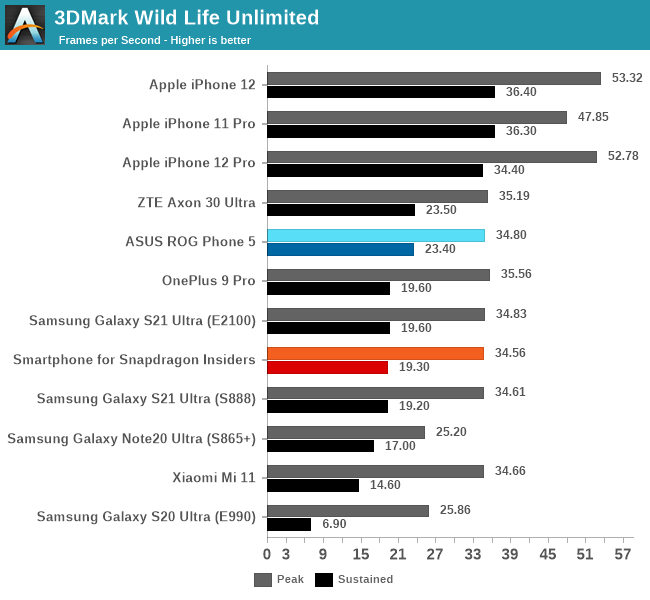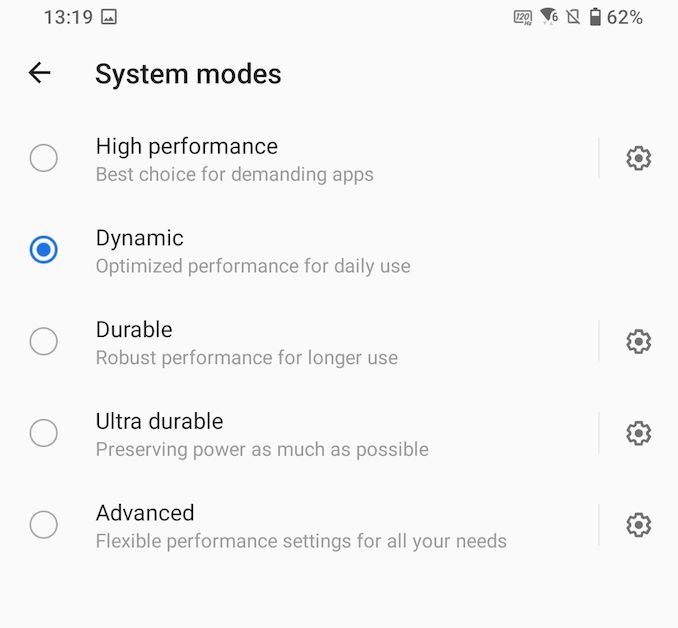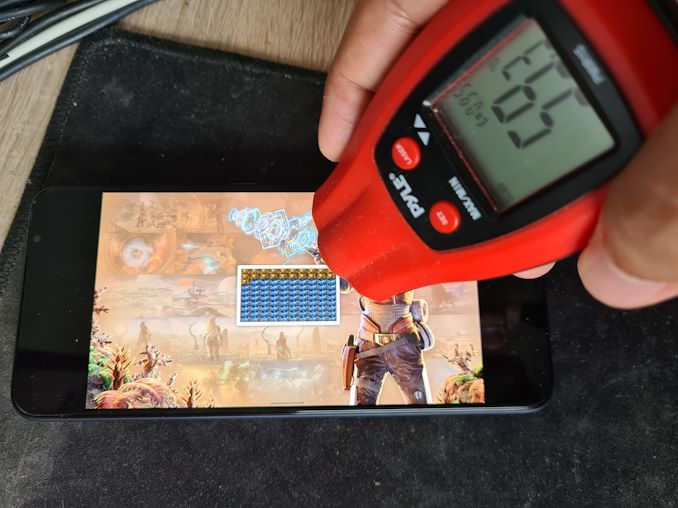The "Smartphone for Snapdragon Insiders" vs ROG5 Preview: Branded vs Original
by Andrei Frumusanu on August 16, 2021 10:00 AM ESTGPU Performance
GPU performance of the Smartphone for Snapdragon Insiders will be very interesting to see. We’ve covered very early on in the year the power characteristics of the Snapdragon 888, lamenting the SoC’s extremely high peak power states. Qualcomm at the time had explained the SoC had higher TDP headroom because there were devices on the market which would be able to support more thermal dissipation. Generally, I disagree with the later statement, as “slab” like smartphones generally are limited to a combined convection and radiation thermal envelope of around 4-5W in a 21-23°C environment. Anything beyond that would only be achievable via active cooling, such as ASUS’s Aero Cooler accessory.
The SSI has no option for active cooling, so it was surprising to me that the phone still had a “High performance” mode in its settings. Although the phone comes in the default “Dynamic” state, I was curious and tested the HP mode:
What resulted is a rather shocking thermal behaviour where the phone literally would not thermal throttle, reaching peak skin temperatures of over 59°C in the middle of the phone’s screen where the SoC and motherboard is located. This is actually the highest figure I’ve ever encountered on a phone ever – past Huawei phones would shut off at this stage, and Xiaomi phones also give off an overheating warning well below this. I stopped the stress test from going any further – this is above first-degree burns temperatures and treading into second degree burn category. Out of principle I just refuse to test devices in such incomprehensible thermal behaviours. The ASUS ROG Phone 5 also has such mode, however it’s only ever available to be enabled only when the external cooling fan is connected, thus never reaching these kinds of temperatures.
In the default “Dynamic” mode, the phone peaks at skin temperatures around 43°C, which is in line with industry standards. The benchmark scores presented are in this mode.

Unfortunately, in this mode, we’re seeing the SSI perform quite averagely. It’s in line with other phones which have similar 42-44°C peak skin temperature limits, however it notably underperforms the ROG Phone 5.





The reason for why the SSI underperforms the ROG Phone 5 is what I had suspected in the introduction, in that the both phones have the SoC and motherboard PCB located at the centre of the phone. The SSI has this Snapdragon logo window located here, which I suspect is acting as a thermal insulator, and reducing the surface area of thermal dissipation from the PCB to the glass back panel. This is just my personal theory just looking at how the phones are built and how the heat is dissipating compared to the ROG 5.
The SSI’s performance here is just mediocre to bad, however it was also to be expected given the SoC’s thermal characteristics. Physics are physics, and there is simply no way for any device out there to sustain more than 5W at reasonable skin temperatures at common indoor ambient temperatures – no matter the internal heat dissipation mechanisms, be it heat pipes, vapour chambers or newer graphite sheets. The SSI is still a glass slab phone like any other, and therefor it will perform like any other due to the fundamental limitations.












43 Comments
View All Comments
Spunjji - Tuesday, August 17, 2021 - link
Willing to bet that the image samples on that DXOMark review won't gel with the official rating...Kangal - Tuesday, August 17, 2021 - link
Came here to say the same thing.I expect QC to be worse than ASUS in photography, or at the best; not much better.
The ASUS RoG 5, gets so much right that it is one of the best phones of 2021. My only suggestions would be to make it smaller and lighter, better ergonomics, durability upgrades, perhaps IP68 certification, more available/affordable, and have better software support (AndroidOne? Bootloader?). Overall, its great and only outdone by the Sony phones.
s.yu - Tuesday, August 17, 2021 - link
Actually they may well do, I think they're cherry-picking the samples in recent years, at least for certain devices. Perception could be manipulated by manually discarding samples with minor focusing errors, vibrations, AWB issues, questionable lighting etc. and that could matter more than the actual performance of the device.Of course anybody could do that, but it's DXO we're talking about.
Mil0 - Wednesday, August 18, 2021 - link
Review is posted https://www.dxomark.com/smartphone-for-snapdragon-...It seems like dxomark reviewed the phone themselves, and they did find some issues with the algorithms.
BAllen - Tuesday, August 17, 2021 - link
Most people don't know that the Adreno 660 is just a 5nm overclocked Adreno 650. They both have the same 1,024 ALU count and design. The Adreno 650/+ runs at 540MHz-670MHz depending on the phone. The Adreno 660 runs at 840MHz. With these SOC's performance scales almost perfect. Each 100MHz clock bump gives the GPU a 100GFlops of FP32 compute. The Adreno 650/+ is rated at 1.2TFlops-1.38TFlops FP32. The Adeno 660 is rated at 1.78TFlops FP32. So you see the picture. And yes i said TFlops. Phones now have 1Teraflop+ GPU's. What's even better is a SD865 device with an Adreno 650 that holds a sustained clock can basically match a overheating, throttling 660.BAllen - Tuesday, August 17, 2021 - link
Also, the ROG 5's 2Vrms 3.5mm headphone jack uses the latest 32bit ESS SABRE qDAC and can push 700Ω 🎧. That with a 6000mAh battery and dual USB-C 3.1 has HDMI and MicroSD storage. So, its basically an upgrade for LG users. Though, i'm plenty happy with my modded LG v60 running A11 and Note 20 U5. The SD865/+ is all anyone would actually ever need for the next 5 years. That's why i bought 2 of each. With the v60 only costing $350-$400 new and the Note 20 UG at $600, who could pass on those deals. I got one v60 basically running at a HTPC hooked up to my LG OLED with a 512GB MicroSD loaded up.Kangal - Tuesday, August 17, 2021 - link
It's been a while since I've looked into the iGPU performance of phones.But with figures like that, it's pretty close to the power of the XB1 and PS4. Impressive. Not to mention, it getting access to newer software/hardware features, and using a more powerful CPU, you could argue they're even closer to that mainstream-2013-benchmark. Well, that is if you actually dock the phone and give it a steady supply of electricity and use some sort of Active Cooling to regulate it.
Then you have Apple. They might actually be more powerful (slightly) than last-gen console's performance. Add the SteamDeck to the conversation, and it's a good time to be a mobile gamer.
zodiacfml - Tuesday, August 17, 2021 - link
dont know whats going with Q these days. they should have Apple M1 like hardware by now but no, we get this 🤮abufrejoval - Tuesday, August 17, 2021 - link
Looks like you're trying to get somebody fired.Just sure hope it's not you!
CyborgAlienRay - Wednesday, August 18, 2021 - link
I wouldn't waste $1500 on an alpha device that's not even remarkable by any means, let alone one with no 3.5mm jack or can remain cool, or have removable memory, the additional headphones are worthless for me, so what about 16GB DRAM, the fact it's got 512GB of ReadOnlyMemory is great but, still not for the additional $500. Wishy-washy camera, overheating, and complete 5G networks doesn't add up to $1400, the rest are boring stats, it even doesn't have the next gen of processors in it, which may have gone a long ways but, still not worth that. Even looks cheap, not sure if that's a Qualcomm decision or an Asus one but, someone dropped the leaded loaded iron ball on someone's head on that one for sure.